Xiaomi Corporation: Mobile Marketing growth
Summary
- Xiaomi’s pushing premiumization in its products can potentially improve its brand image.
- Xiaomi faced many YoY and QoQ challenges that may have slowed down the company’s growth in the near term.
- The company’s entering the Smart E.V. and humanoid robot market and aims to be an industry leader in the Smart E.V. space by 2024.
- Xiaomi’s investments and market expansion will increase the company’s revenues and profitability. Combined with my analysis and Valuation, I rate the stock as a Buy.
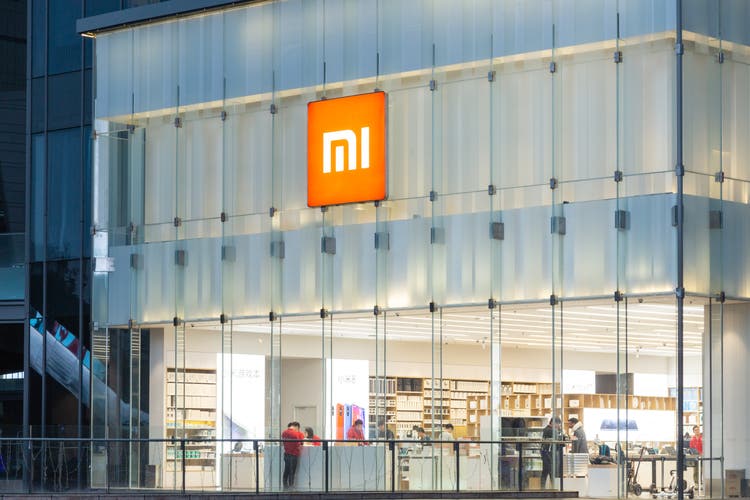 iStock
iStock
Investment Thesis
Xiaomi (OTCPK:XIACY) is currently facing near-term headwinds, similar to what companies in the industry are facing. The company’s revenue decreased YoY [year-over-year]. I still believe that these are just near-term headwinds that companies face due to high inflation rates, weaker consumer spending, high interest rates, stronger U.S. dollar, etc. However, I do think that this is the right time for investors to invest in Xiaomi because of the following reasons:
- Improving brand image through premiumization of products.
- Significant IoT services & overseas growth.
- Expansion to the Smart EV Market through autonomous driving technology.
- Potentially can increase its global market share.
- Improving its profitability and margins.
Although there are many factors and risks associated with these claims, I believe that these performances, improvements, and innovations will help Xiaomi grow in the tech market. Considering that the price is near its lowest point for the past year, I think this is the suitable time to buy Xiaomi shares, assuming market conditions will ease for the following months, if not years.
Complications That Xiaomi Is Facing
Similar to most, if not all, companies in the world, Xiaomi is facing some complications in their company. Complications such as macroeconomic headwinds caused global inflation and volatility in foreign exchange. These headwinds will significantly affect Xiaomi’s sales and growth rates, especially in the IoT overseas market expansion that they’ve been doing the past few quarters (which I’ll talk more about in the next section). Here are some of the challenges that Xiaomi is facing with its IoT & Overseas market:
Challenges Faced By Xiaomi’s IoT Overseas Market
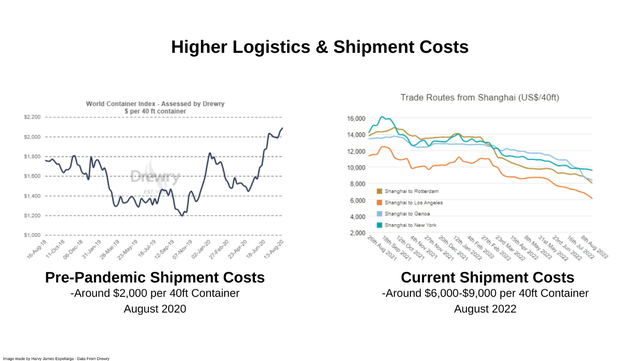 Shipment Costs - Drewry's Data
Shipment Costs - Drewry's Data
Xiaomi faced significant challenges in its IoT services and overseas market. According to Drewry’s data, the world container index cost around $2,000 per 40ft container back in 2019-2020 (pre-pandemic costs). However, the current shipment costs are about $6,000-$9,000 per 40ft, which is a 200-350% increase in freight costs. According to Xiaomi’s second-quarter results:
“...IoT and lifestyle products revenue in overseas markets was affected by global inflation and other macroeconomic factors, as demand decreased year-over-year for discretionary items such as scooters and robot vacuum cleaners.”
- Xiaomi Second-Quarter Results
High logistics costs can result from inflation caused by COVID-19 & geopolitical issues around the world that affect the price of crude oil and are expected to increase within the coming months. Aside from the high logistics costs, Alain Lam, the Vice President, Chief Financial Officer, and Chief Executive Officer of Airstar Digital Technology, also stated that macro impacted the overseas market:
“…some of the macro factors that we talked about, including high inflation, high interest rate, etcetera, has really hit the consumption for a lot of our users in the overseas market. So, they cut down on some of the discretionary electronic spend, such as our robot cleaners, our scooters, etcetera.”
- Xiaomi’s Q2'22 Earnings Call
With that being said, high logistics costs and macro factors (that affect consumer spending) affect Xiaomi with its overseas market expansion. This can be seen through the company's decline in revenue: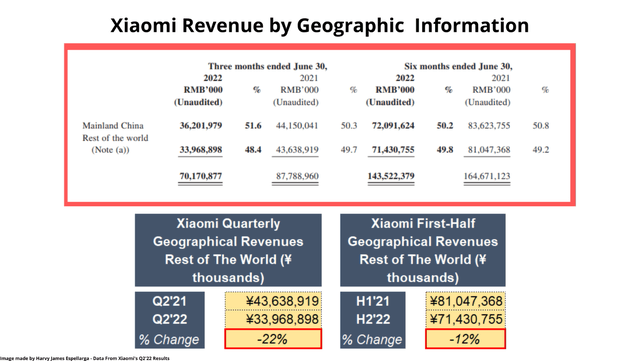 Xiaomi Second-Quarter Results
Xiaomi Second-Quarter Results
In the company's second-quarter results, there was a 22% decline in its YoY performance in the overseas market, and a 12% decline in its first-half performance, compared to the previous year. However, even though Xiaomi is facing these headwinds, I still think that a decrease in sales with IoT lifestyle products like robot cleaners and scooters won't affect the company's long-term performance once the macro situation becomes better, considering that it accounts for roughly 48-49% of the company's revenue.
Is Premiumization Going To Affect Xiaomi's Margins?
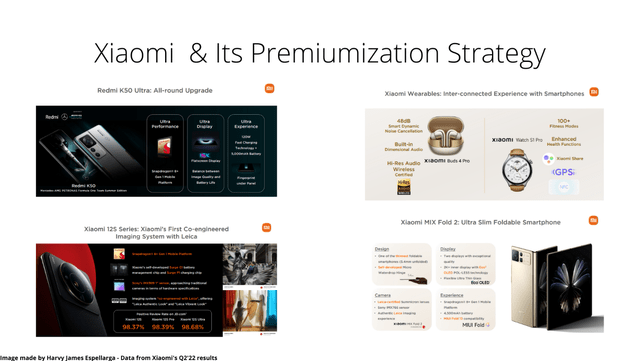
Author – Data from Xiaomi's Q2'22 Results:
On the Q2'22 Earnings call, Xiaomi mentioned that they are investing more in its premiumization strategies by releasing higher-quality phones such as the Xiaomi MIX Fold 2 (features Xiaomi's self-developed Micro Waterdrop Hinge and flexible ultrathin glass, achieving width of 5.4 millimeters unfolded and a weight of 262 grams), Redmi K50 Ultra, and Xiaomi 12S Series together with the Xiaomi Buds 4 Pro (improvement in sound quality, noise cancellation, and dimensional audio so that users can experience immersive life-like sound.) and Xiaomi Watch S1 Pro (that features exquisite appearance, full range of fitness modes and multiple health functions).
Xiaomi Gross Profit Margins
I think that Xiaomi's premiumization strategy is good. The effects of premiumization won't immediately be seen due to near-term headwinds (I'll mention them below). Still, I believe that profit margins will improve once the global economy stabilizes, there's an increase in consumer demands, and logistics costs become cheaper. However, the company had a 3.21% QoQ [quarter-on-quarter] (17.33% in Q1'22 vs. 16.77% in Q2'22) and a 2.81% YoY (17.26% in Q1'21 vs. 16.77% in Q2'22) decline in gross profit margins, which I think will continue for the next few months and maybe even up to H1'23, because of the holiday season in the second half of the year, and efforts to clear inventory impairment.
Xiaomi's gross profit margins have decreased due to the 618 Shopping Festival, China's second largest and most important Shopping Festival, and the stronger U.S. dollar.
I think that the company's gross profit margins will continue to decrease in the second half due to events like Diwali, the Double-11 event, Black Friday, Christmas, etc.
Increased Inventory Impairment Compared To Last Year's Half
One thing I'd like to look at is the company's increase in inventory impairment. This can signify that their products have gone below book value but are still considered to be sellable products. Xiaomi had ¥1.3 billion in inventory impairment and grew to ¥2.4 billion, or an 88% growth in inventory impairment.
Xiaomi has already cleared some of its inventory from its 618 events. However, I don't think the company can remove all of it in the second half of 2022. Management says it's due to lower overseas consumption and a stronger U.S. dollar but states it is not a problem and can be cleared with sufficient measures. Xiaomi would have to spend more on marketing and ad campaigns to get the inventory cleared or put these items on sale.
Strengthen Competitiveness – Xiaomi R&D Investments
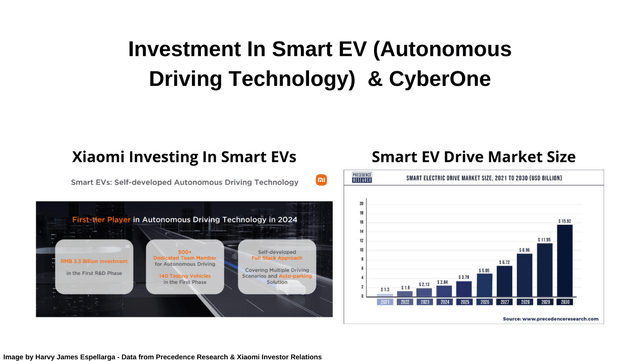 Xiaomi Investor Relations & Precedence Research
Xiaomi Investor Relations & Precedence Research
Besides smartphones and IoT lifestyle products, Xiaomi is looking to expand in the Smart E.V. market and A.I. Robot market. According to Precedence Research, the smart electric vehicle drive was valued at around $1.2 billion in 2021 and is expected to reach about $15.92 billion in 2030 at a CAGR of 33.28%.
In August 2022, Xiaomi announced that they would adopt their own self-developed autonomous driving technology and are planning to invest ¥3.3 billion in phase one. With a team of 500 world-class professionals, 140 testing vehicles, and management is aiming to be an industry leader in Smart E.V. by 2024. Being an industry leader by 2024 is very ambitious for the company. I don't think they'd be able to achieve such a feat quickly, but I do like the idea of expanding in the Smart E.V. market. Without further updates and announcements from management, I am optimistic about the change.
However, if they did want to pursue entering the Smart E.V. market, the company would need to invest more in R&D and spend more on high-cost equipment, and it may be challenging to sell these vehicles overseas (Inadequate charging stations in emerging countries in Asia), especially with Tesla (TSLA) dominating the Smart E.V. space in the U.S., which can hinder or at least slow down the expansion progress in these markets.
Could they sustain these investments & equipment costs, and maintenance? I think they have enough cash to cover. The company had ¥3.8 billion in the current quarter, a 23% growth YoY, with management stating that they will be spending ¥100 billion in the next five years. Let's think about it this way, I believe that their premiumization strategy will take effect in 2023. If not, maybe from 2024 onwards, and with its IoT services proliferating YoY, the company will have ample cash to support its R&D investments. A better global economy will also boost its cash because it'd be spending less on logistics and allocate that cash back to investments. Xiaomi Investor Relations
Xiaomi Investor Relations
Xiaomi also released CyberOne, their humanoid robot capable of bipedal motion balancing through mechanical joint motors and full body algorithms. It can detect human emotions and reconstruct 3D virtual environments of the real world using the company's self-developed audio and vision algorithms. This may sound great, but management also mentioned that the cost was too high for these humanoid robots, which is still in their very early stage.
I believe that costs on this humanoid robot will remain high until they've done sufficient research on how to lessen costs. According to MarketsAndMarkets, the humanoid robot market will be valued at $1.5 billion in 2022 and is an excellent opportunity for the healthcare sector, especially in hospitals, where they can help supply food and medicines. Overall, I think high costs in CyberOne are expected, considering that Xiaomi is making one with self-developed features. Investors should consider this, if Xiaomi becomes successful in the humanoid robot market (a man-sized IF), it could add more to Xiaomi's revenue mix, which means more cash, and more money reinvested in the company, together with its premiumization in smartphones, and investment efforts in Smart E.V.
Notable Xiaomi Achievements
Xiaomi achieved many things in Q2'22. In August 2022, the company was listed in the Fortune 500 for the fourth consecutive year and ranked 266, advancing 72 spots compared to the previous years, which is an excellent achievement as Xiaomi is getting recognized even more globally. In July 2022, the company was selected into Forbes China's 2022 Best Employers of The Year.
Meanwhile, they also established Beijing Municipal Natural Science Foundation, Xiaomi's joint innovation fund, to support fundamental research in A.I., digital information, and intelligent manufacturing. Here are other Xiaomi achievements that investors should know:
Increasing Numbers Of Monthly Active Users In Connected Devices
Xiaomi's global MIUI (Xiaomi's mobile operating system) MAU (Monthly active users) reached 547 million in June 2022, and the company's MIUI MAU in Mainland China increased for seven consecutive quarters, reaching 140 million.
Undisrupted By Global Smartphone Industry Shipments
In Xiaomi's Q2'22 results, the company still achieved QoQ growth and managed to increase its global market share for two consecutive quarters from 12.5% in Q4'21 to 13.8% in Q2'22, while the worldwide smartphone industry shipments dropped 9% QoQ. Still, more shipments don’t necessarily mean more revenue because the Smartphone segment still suffered a 40% decrease in revenue.
My Valuation - Why Investors Should Care About Xiaomi
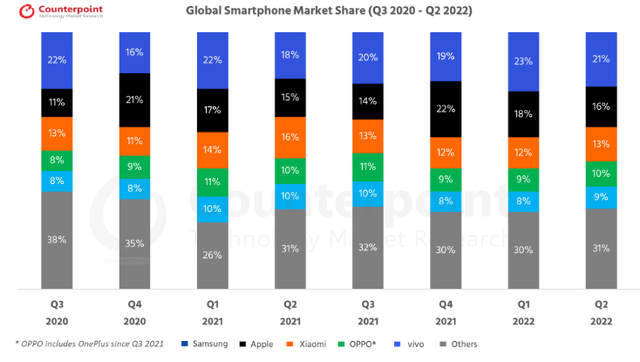 Global Smartphone Market Share – Counterpoint
Global Smartphone Market Share – Counterpoint
To start things off with the valuation side, Xiaomi is still maintaining its spot in the global smartphone market share, taking about 13% of the smartphone market share, compared to its YoY market share of 16%. It is a 19% decrease in market share, but it is still hovering around the low double-digit number, the average market share the company has achieved for the past seven quarters.
Xiaomi's revenues decreased YoY & QoQ by 20% and 4.34%, respectively, due to a 28.5% decline in Smartphone revenues, 4.5% decline in IoT & Lifestyle Products revenues, and a 1% decline in Internet Services revenues, resulting in an overall YoY decline of 20% (Although I did mention that the company had a QoQ decrease, I don't find it meaningful to compare the segmental revenue as the first quarter of the year doesn't include the 618 Festival which plays a considerable role in Xiaomi's revenue mix).
Xiaomi's YoY gross profit also has fallen off by 22% due to the company's efforts to clear inventory impairment (which we talked about earlier, and there's still much inventory to clear out), for the company's enhanced promotional efforts for the 618 Shopping Festival in Mainland China which lead to an 8.7% YoY gross margin decrease in the Smartphone business, and due to the U.S. dollar appreciation. This is something that investors need to keep an eye on because holiday sales in the second half of 2022 can further affect its gross profit growth due to heavy discounting in products.
Moving over to the balance sheet, Xiaomi has ¥28.2 billion in cash & cash equivalents (a 12% decline compared to the previous year's performance of ¥32 billion in cash & cash equivalents), ¥180 billion in current assets, and ¥107 billion in current liabilities, which gives us a 1.70 current ratio, which is still healthy. However, if Xiaomi wants to clear its inventories, it will spend a lot of cash on marketing and allocate more ad budget. The company's maintaining its gross profit margin, averaging 17% for the past eight quarters, which means it is still maintaining its profitability margins, despite macro factors, a strong U.S. dollar, and the challenges I've mentioned above.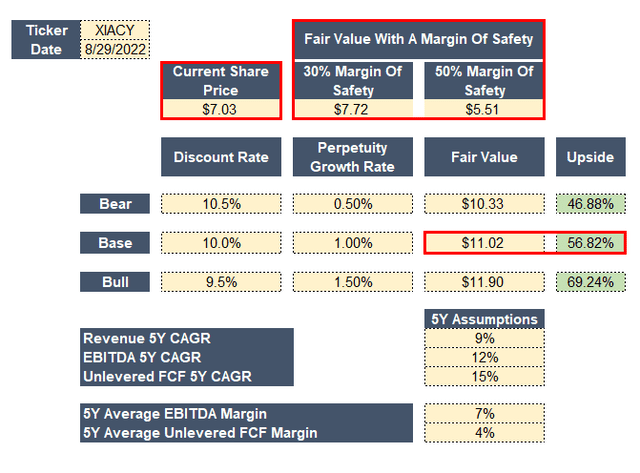 Author – Data From Xiaomi's Historical Financial Statements
Author – Data From Xiaomi's Historical Financial Statements
I did a 5Y DCF Model through the Gordon Growth Exit method for the valuation. So my assumptions can be found below, a 9% CAGR assuming the economy will stabilize 2 years from now. I also assume that the company would have better EBITDA margins. I used the EBITDA margin for the past five years for that. My base case estimates on the image shown are what I expect the stock's price should be for five years, and although I included the Bear and Bull case (together with its associated share price & upside %), the only difference is the perpetuity growth rate and discount rate I used for Bear and Bull is 0.5% lesser/higher compared to the Base case. However, here are the alternative scenarios for the Bear and Bull cases:
The Alternative Bear Case: For my revenue projections, I projected a 15% revenue growth in 2022, 10% for 2023, and 7.5% for the following years. It's harder for a company to grow once it reaches ¥450 billion or 66 billion USD. I'd assume that revenue growth would slow if we predict that the company still accounts for 13-16% of the market shares in the Global smartphone market.
I also think that revenue will not be driven by volume but instead by price. Xiaomi is pushing for premiumization, prices will naturally go higher, and if the company still allots money on R&D to make costs even cheaper, then there will be a lesser expense in COGS. I'd also assume that IoT lifestyle products will be more prevalent by this time as Xiaomi is releasing a lot of IoT products.
For the Bear case, I'd also assume that the company would maintain at least 5% and then increase to 6% by 2024, with CapEx at least a constant 2%, 1% constant D&A, and an NWC of -0.2% for the 5Y estimates. So with all the assumptions, we have a 5Y average of 9% in FCF or a 3% CAGR in FCF (2022 will have lesser cash, a negative -22% which is expected because of how much money the company is investing, the amount of inventory to clear, the appreciation of the U.S. dollar, and the associated geopolitical risks that come with it).
To get the P.V. of the Discrete Cash Flows, we discount the FCF. After running the numbers, we get a P.V. of Discrete Cash Flows of ¥54 billion and a P.V. of the terminal value of ¥118 billion. We get an E.V. of ¥172 billion (0.5% perpetuity growth rate). After that, we add back cash, investments, minus debt, and liabilities, and together with 5.1 million shares outstanding, we have an implied stock price of ¥58.4 or $8.51 as our implied share price, which still has a 20% upside.
The Alternative Bull Case: For the bull case, I'll be using similar assumptions, except revenues will be up 15% in 2022 & 2023 and become a constant 10% for the following years (I think it's hard to maintain that revenue growth, but let's assume that Xiaomi achieves to be one of the industry leaders in Smart E.V., especially if they're targeting the middle class, and have the ample amount of E.V. chargers by 2024, then this could be a possibility). Part of the 10% is also from the growth in IoT services and lifestyle products. If these products sell like crazy in the overseas market, then the 10% revenue growth could be achievable in 5 years, assuming that the market conditions are at ease by then.
With the Bull case, I'd also assume that the company would maintain around a 6% up to 7% EBITDA margin from 2024 onwards. With a discount rate of 9.5% (assuming the global economy stabilizes, demand increases, and logistics costs are back to an average of $1,750-$2,000 per 40ft pre-pandemic levels). Then we're looking at a P.V. of Discrete Cash Flow of ¥76 billion and a P.V. of Terminal Value of ¥217 billion, E.V. of ¥293 billion (perpetuity growth rate of 1.5%). After that, we add back cash, investments, minus debt, and liabilities, and together with 5.1 million shares outstanding, we get an implied share price of ¥82 or $12, which is not far from the image above.
Together with my thorough analysis of the company and its upside. I would like to refer my Valuation to the base case and rate the stock as a Buy since it is currently trading below its fair value of $11. With a 50% margin of safety, we're looking at an ideal price of $5.51 if you want minimal risks in your investments. Regardless, even with a 30% margin of safety, the stock is priced at $7.72, which is chill cheaper than its current price. There are risks associated with the alternative assumptions I've made with the Bear and the Bull case, so please trade at your own risk.
Investor Takeaway:
I think Xiaomi's taking steps to become an industry leader in some markets while trying to improve its brand image through premiumization. They are pushing the significant IoT services & overseas growth, which can add more to the company's geographical revenue mix. They are also taking steps in their self-developed technology, the Smart E.V. market, and the humanoid robot market. I believe that the stock is profitable, and the headwinds are temporary. My valuation shows that the stock is a buy with a nice upside. Overall, I rate the stock as a Buy with my fundamental analysis of the company.
Thank you for your time, and have a good day!
In constant search of undervalued stocks suited for short and long-term investments. Accountancy, Business, and Management Student. Harvy mostly writes about growth and value tech stocks, analyzes them, and shares his insights with his readers. He is a new writer and welcomes all his readers to share their comments, thoughts, and expressions in his articles.
Harvy is a market fanatic motivated to make well-researched articles relating to Large-Cap, Tech, Internet, Gaming, Semiconductor, Value, and Growth. He takes pride in his work and takes constructive criticism to improve his writing and understanding of the market.
Assumptions that the author makes are based on his personal opinions. Trade at your own risk. I am not liable for any losses on your end.
Seeking Alpha's Disclosure: Past performance is no guarantee of future results. No recommendation or advice is being given as to whether any investment is suitable for a particular investor. Any views or opinions expressed above may not reflect those of Seeking Alpha as a whole. Seeking Alpha is not a licensed securities dealer, broker or US investment adviser or investment bank. Our analysts are third party authors that include both professional investors and individual investors who may not be licensed or certified by any institute or regulatory body.
Already registered?

































